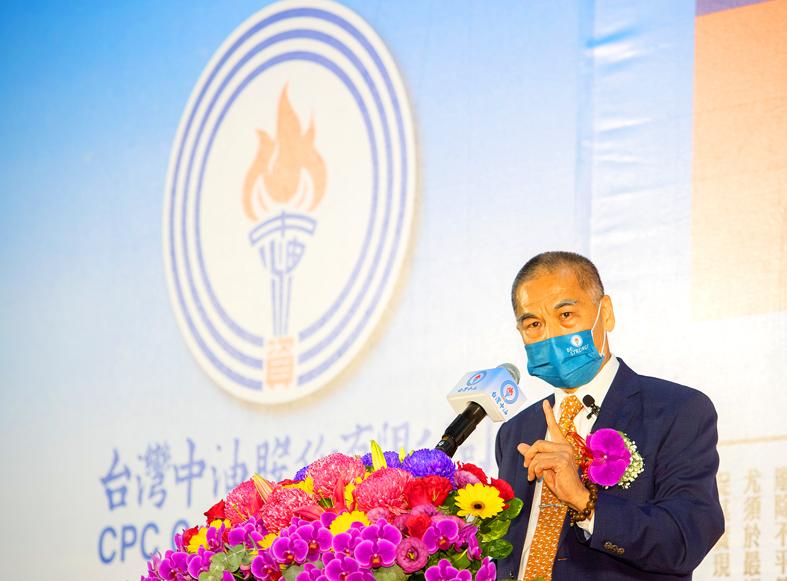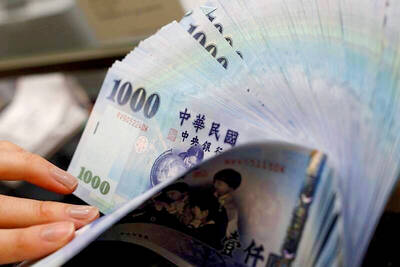State-owned fuel supplier CPC Corp, Taiwan (CPC, 台灣中油) has racked up significant losses since late last year, while stuck between high natural gas costs and a government-imposed freeze on raising end-user prices to stem inflationary pressures.
The mounting losses, which appear to be unsustainable, have cast doubt on CPC’s ability to make the investment called for in the initial phase of the government’s pledge to reach net-zero carbon emissions by 2050, and its new chairman said raising prices might be the only solution.
Speaking on Tuesday, shortly after taking over as CPC chairman, Lee Shun-chin (李順欽) said the company’s losses totaled NT$30.5 billion (US$1.05 billion) in the first quarter and would rise to NT$65 billion by the end of the month if domestic oil and natural gas prices remained unchanged.

Photo: CNA
The NT$65 billion estimate represents half of the company’s paid-in capital, and Lee said several proposals to improve the company’s financial structure have been floated and would be presented to its board at a meeting next month.
One solution is to include imported energy costs in domestic prices, Lee said, but that would be “contingent on approval from the government.”
The government has required CPC to freeze natural gas prices for retail users since January last year, despite a major increase in the global price of liquefied natural gas, resulting in a loss of NT$43.4 billion for last year, the company’s highest in 13 years.
The government gave the firm a small reprieve last month, when it allowed CPC to raise natural gas prices to power generation and electricity distribution businesses, such as Taiwan Power Co (Taipower, 台電), by 10 percent.
Prices for residential and most industrial users remained the same, and the NT$51.7 billion in higher liquefied natural gas costs the company had to eat in the first quarter was already half of the NT$104.8 billion in increased costs it absorbed last year.
“The 10 percent increase was made with the consent of the Ministry of Economic Affairs,” because CPC only has the discretion to raise prices by 3 percent per month, but no more than 6 percent every quarter, Lee was quoted as saying in local media.
Even with the latest price increase, CPC sells natural gas to Taipower and other power generation and electricity distribution businesses at between NT$12 and NT$13 per cubic meter, lower than its cost of NT$20 per cubic meter, Lee said.
Because CPC and Taipower have not passed on the higher costs to end users or had limited price increases, inflation in Taiwan was a relatively low 2.81 percent in the first quarter, compared with 5.8 percent in January and 6.3 percent in February in Organisation for Economic Co-operation and Development countries excluding Turkey.
That would change if Lee is able to pass on more of CPC’s rising prices to consumers.
If he cannot, and the losses continue to mount, it would put the government “in a very disadvantageous position” on new energy development to attain net-zero carbon emissions by 2050, Tamkang University economics professor Liao Huei-chu (廖惠珠) was cited as saying by the Chinese-language China Times.
CPC might withhold investing in “less-urgent” renewable energy as has been the case with Taipower, which put off a power grid project because it was losing money, Liao said.

Merida Industry Co (美利達) has seen signs of recovery in the US and European markets this year, as customers are gradually depleting their inventories, the bicycle maker told shareholders yesterday. Given robust growth in new orders at its Taiwanese factory, coupled with its subsidiaries’ improving performance, Merida said it remains confident about the bicycle market’s prospects and expects steady growth in its core business this year. CAUTION ON CHINA However, the company must handle the Chinese market with great caution, as sales of road bikes there have declined significantly, affecting its revenue and profitability, Merida said in a statement, adding that it would

MARKET LEADERSHIP: Investors are flocking to Nvidia, drawn by the company’s long-term fundamntals, dominant position in the AI sector, and pricing and margin power Two years after Nvidia Corp made history by becoming the first chipmaker to achieve a US$1 trillion market capitalization, an even more remarkable milestone is within its grasp: becoming the first company to reach US$4 trillion. After the emergence of China’s DeepSeek (深度求索) sent the stock plunging earlier this year and stoked concerns that outlays on artificial intelligence (AI) infrastructure were set to slow, Nvidia shares have rallied back to a record. The company’s biggest customers remain full steam ahead on spending, much of which is flowing to its computing systems. Microsoft Corp, Meta Platforms Inc, Amazon.com Inc and Alphabet Inc are

RISING: Strong exports, and life insurance companies’ efforts to manage currency risks indicates the NT dollar would eventually pass the 29 level, an expert said The New Taiwan dollar yesterday rallied to its strongest in three years amid inflows to the nation’s stock market and broad-based weakness in the US dollar. Exporter sales of the US currency and a repatriation of funds from local asset managers also played a role, said two traders, who asked not to be identified as they were not authorized to speak publicly. State-owned banks were seen buying the greenback yesterday, but only at a moderate scale, the traders said. The local currency gained 0.77 percent, outperforming almost all of its Asian peers, to close at NT$29.165 per US dollar in Taipei trading yesterday. The

The US overtaking China as Taiwan’s top export destination could boost industrial development and wage growth, given the US is a high-income economy, an economist said yesterday. However, Taiwan still needs to diversify its export markets due to the unpredictability of US President Donald Trump’s administration, said Chiou Jiunn-rong (邱俊榮), an economics professor at National Central University. Taiwan’s exports soared to a record US$51.74 billion last month, driven by strong demand for artificial intelligence (AI) products and continued orders, with information and communication technology (ICT) and audio/video products leading all sectors. The US reclaimed its position as Taiwan’s top export market, accounting for